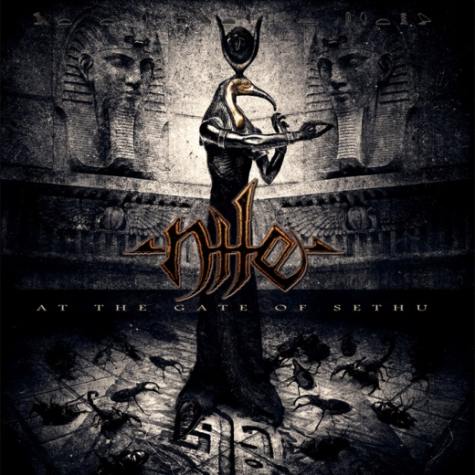Nile’s sound comes from a mixture of down-tuned riffing, inhuman drum speeds, and lyrical content about ancient Egypt and Mesopotamia – making them one of the most technical groups that exists in the Extreme Metal genre. Karl Sanders was gracious enough to spend some time doing an interview with us about his writing process, heavy metal, and SONAR.
1. How long have you been a Cakewalk user? What version did you start with? I have been a Cakewalk user since the mid 90’s, starting with Cakewalk Pro Audio 5. I was writing songs and recording song demos of the early Nile songs that eventually became the Nephren-Ka album. I really went nuts with all available MIDI and audio tracks– adding tons of ethnic instruments and MIDI orchestrations to the record. Then when it came time to tour the album, I had the insane idea that maybe we could have all those extraneous tracks available to us in our live performances if I brought my PC with me and just ran Cakewalk. At that time in 1996-97 this was an unheard of concept in Death Metal and everyone thought I was a lunatic. Nowadays you see bands of all genres using laptops and iPads everywhere you look.
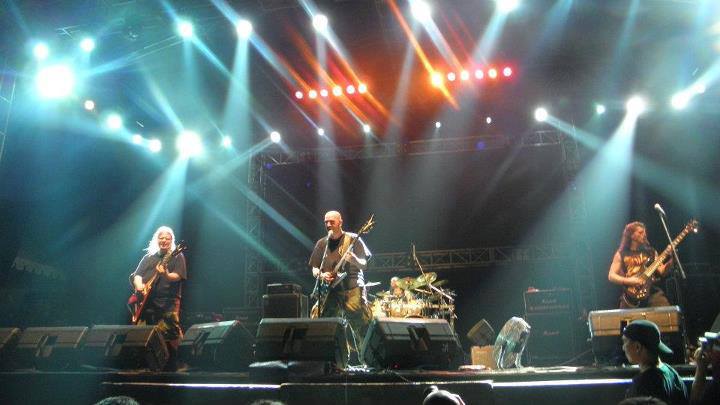
2. You’re the main songwriter for Nile, a group that combines concepts of ancient middle eastern cultures and extreme metal. What’s it like to have influenced the lives of over 20 years worth of metal fans and musicians?  It’s definitely an honor, I have received lots of letters and emails over the years from people everywhere across our Earth – sharing their appreciation for what Nile has done and how it has inspired them. It really means a lot to me, but day to day, I try to really stay focused on the task of making music and not dwell on those kinds of warm fuzzy distractions.
It’s definitely an honor, I have received lots of letters and emails over the years from people everywhere across our Earth – sharing their appreciation for what Nile has done and how it has inspired them. It really means a lot to me, but day to day, I try to really stay focused on the task of making music and not dwell on those kinds of warm fuzzy distractions.
3. Do you have a process for researching, creating, arranging, and recording your music? Normally I like to start with the lyrics first. I just let the words guide the creation of the music, kind of like a script . It really helps with freeing one’s self from pre-conceived shackles of rigid song arrangement. I am always extra willing to follow errant paths of inspiration – But I believe there should ideally be no restrictions or “formula” that one has to follow in the path of writing music.
4. How do you use SONAR in your work with Nile both in the studio and live? Are there any specific features that you find yourself constantly returning to? For live, definitely the Play List. 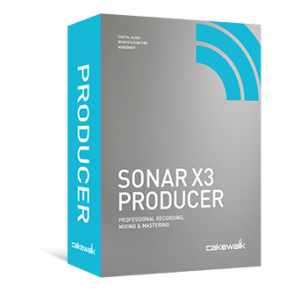 Its absolutely the most ingenious – if humble – feature of ANY DAW for live use. Its EXACTLY the right set of tools for the job.I should know, because for almost two decades I have been using the Playlist under the “Trial-by Fire” that is live Death Metal. I have, admittedly, learned quite a lot through the ruthless and unforgivable conditions of live touring. During a show there is no room for error. There is nothing more humiliating than being onstage ,under the gun and stressed, and then committing some dumb human error that necessitates a computer reboot. Thankfully, laptop computers have become much more reliable these days than when I started out with Nile in the 90’s. I have always written Nile songs inside of SONAR in my home studio – all the way back to the early years with Cakewalk Pro Audio 5. Cakewalk is just an incredibly quick and easy tool to work with.
Its absolutely the most ingenious – if humble – feature of ANY DAW for live use. Its EXACTLY the right set of tools for the job.I should know, because for almost two decades I have been using the Playlist under the “Trial-by Fire” that is live Death Metal. I have, admittedly, learned quite a lot through the ruthless and unforgivable conditions of live touring. During a show there is no room for error. There is nothing more humiliating than being onstage ,under the gun and stressed, and then committing some dumb human error that necessitates a computer reboot. Thankfully, laptop computers have become much more reliable these days than when I started out with Nile in the 90’s. I have always written Nile songs inside of SONAR in my home studio – all the way back to the early years with Cakewalk Pro Audio 5. Cakewalk is just an incredibly quick and easy tool to work with.  You can get going with an idea quickly and without a frustrating learning curve. If you can find your way around ubiquitous and familiar Programs like MS Word or Excel, than you will feel very much at home behind the wheel of SONAR. The pay-off is easily transferring tracks of much of the work done at home in the demo stage directly and cleanly to the album production stage. It makes the whole paradigm of composing songs for Nile a much more fluid and “realizable” undertaking.
You can get going with an idea quickly and without a frustrating learning curve. If you can find your way around ubiquitous and familiar Programs like MS Word or Excel, than you will feel very much at home behind the wheel of SONAR. The pay-off is easily transferring tracks of much of the work done at home in the demo stage directly and cleanly to the album production stage. It makes the whole paradigm of composing songs for Nile a much more fluid and “realizable” undertaking.
5. Of the multiple releases Nile has put out, which record was your favorite to record and why? Probably the first record, “Amongst the Catacombs of Nephren-Ka”. 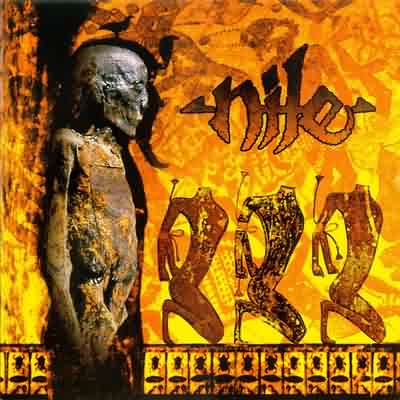 We had almost no budget and little hope of success, but we didn’t care. We were full of fire and intoxicated with the sheer thrill of the limitless possibilities of creatively doing whatever we wanted. The unheard freedom of syncing my PC to the studios ADAT rig, transferring audio tracks into my PC, and creatively mangling them in Cakewalk and Sound Forge was mind blowing. Of course today that’s no big deal, but back then it seemed like every swipe of the mouse was imbued with zeus-like powers of unbridled creative fire.
We had almost no budget and little hope of success, but we didn’t care. We were full of fire and intoxicated with the sheer thrill of the limitless possibilities of creatively doing whatever we wanted. The unheard freedom of syncing my PC to the studios ADAT rig, transferring audio tracks into my PC, and creatively mangling them in Cakewalk and Sound Forge was mind blowing. Of course today that’s no big deal, but back then it seemed like every swipe of the mouse was imbued with zeus-like powers of unbridled creative fire.
6. What are your thoughts on the role of technology in Heavy Metal? Well, it’s a double edged sword. On the one hand, with todays technology, metal bands can capture their music with heretofore unimaginable clarity and precision. That’s good, but today’s technology has also made it possible for a lot of bands that can barely play their own material make records showcasing seemingly superhuman levels of virtuosity. The problem is that if you go watch some of these bands live, they can’t even come close to what you hear on their records. I think there is something inherently wrong in that. That’s why with Nile, if you come see us play live, we go to great lengths to deliver exactly what is on our albums.
7. What kind of PC rig do you have at home? It’s a custom build PC. Liquid-Cooled Intel i-7 3030k 3.20ghz processor, 64 GB of RAM, Vertex SSD, with multiple 2TB WD Caviar Black Data drives. I am running Win7 64 , with Dual-Nvidia graphics cards so I can have 3 screens going. On my work desk I have twin 28″ monitors, and a 40″ flatscreen mounted on the wall above. I always keep the mixer on the 40″ flatscreen, the track view on bottom left screen, and bottom right screen for plugins. The screensets feature is a blast with 3 monitors. 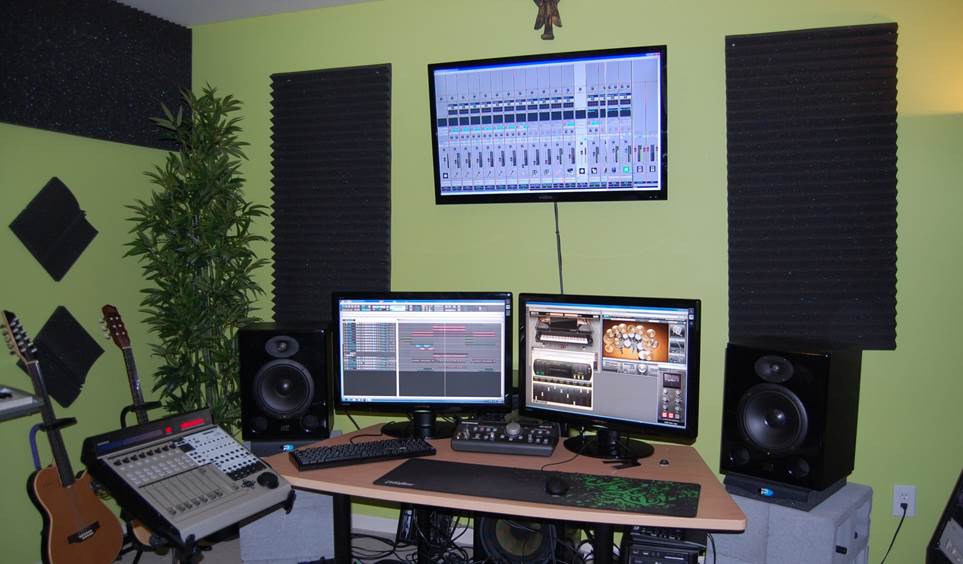 I love it because now I never waste precious creative time constantly resizing windows. When I get an idea- I like to work on it right then – BLAM! Another big help – because I work alone tracking most of the time – is my control surface. The transport and mix functions are super easy to use one-handed while tracking guitar or self-tracking vocals. When I am recording I don’t even touch the mouse anymore till its time to edit.
I love it because now I never waste precious creative time constantly resizing windows. When I get an idea- I like to work on it right then – BLAM! Another big help – because I work alone tracking most of the time – is my control surface. The transport and mix functions are super easy to use one-handed while tracking guitar or self-tracking vocals. When I am recording I don’t even touch the mouse anymore till its time to edit.
8.What other projects are you currently working on? Do fans have anything to look forward to in the near future? At the moment, I am focused on writing songs for the new Nile record. We also have a US/Canadian tour coming up in April . Hope to see ya there!
Karl Sanders official Facebook page
NILE official website and official Facebook Page.


